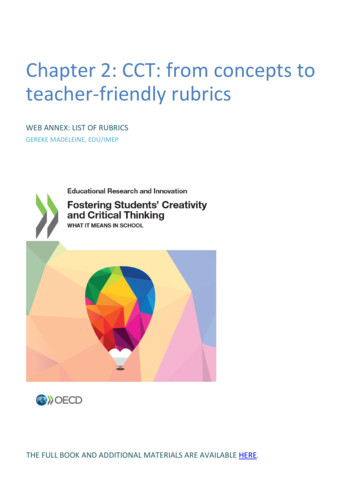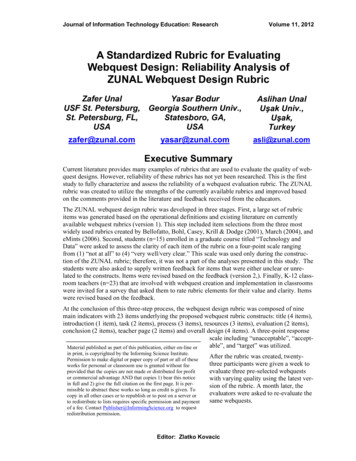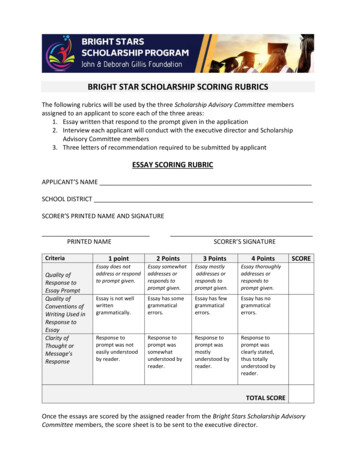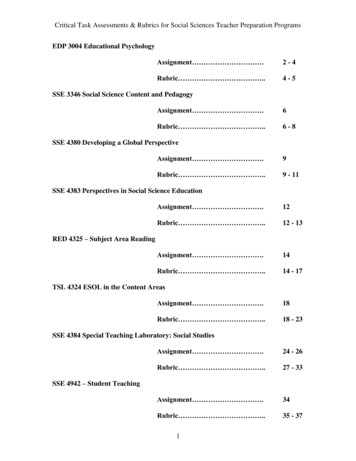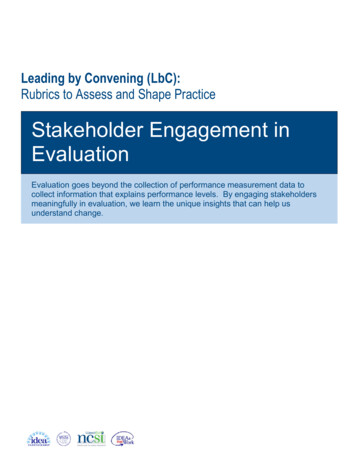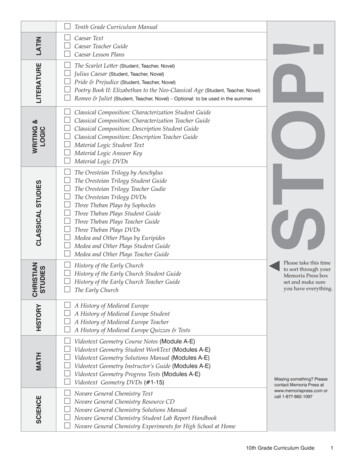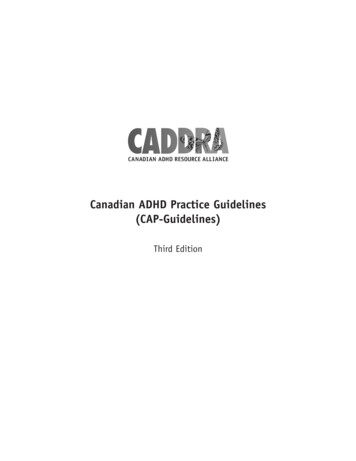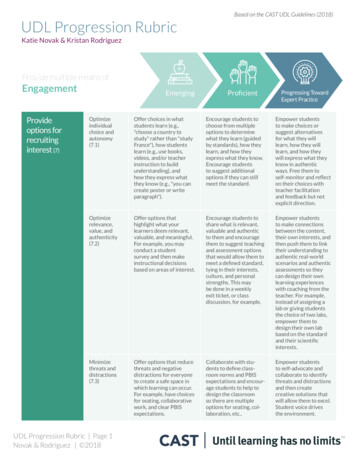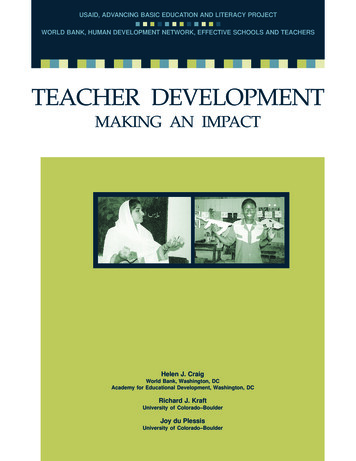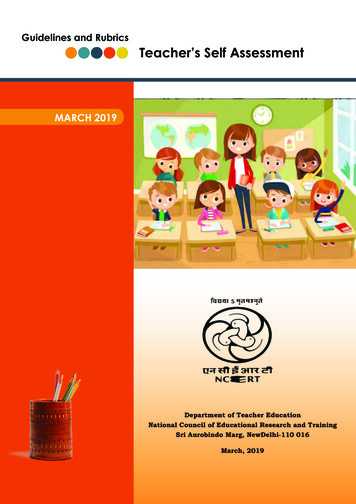
Transcription
Guidelines and RubricsTeacher’s Self AssessmentMARCH 2019Department of Teacher EducationNational Council of Educational Research and TrainingSri Aurobindo Marg, NewDelhi-110 016March, 20191Guidelines and Rubrics Teacher’s Self Assessment
Table of ContentsForeword3Preface4List of Abbreviations5Introduction6Purpose of Teacher’s Self Assessment7Teacher’s Self Assessment Rubrics (TSAR)8Structure of TSAR8Guidelines for Teachers11Guidelines for Head Teachers/Principal/CRC/BRC/DIET11Guidelines for Administrators (District/State level)12Teacher’s Profile13Teacher’s Self Assessment Rubrics15Appendix322Guidelines and Rubrics Teacher’s Self Assessment
ForewordTeachers play a crucial role in shaping the minds of children and in turn the quality ofeducation. Teachers are expected to demonstrate understanding of subject matter; establish apositive relationship with students; create an effective learning environment to ensure enrichingexperiences; conduct students’ assessment; work closely with colleagues and the community; andexhibit professional commitment and accountability. NCERT has developed Learning Outcomesfor elementary classes in various subjects and Learning Outcomes for secondary classes are beingfinalized. To help the teachers understand and achieve the learning outcomes as per curricularexpectations, some suggestive pedagogical processes are also provided in the document of LearningOutcomes.In 2013, NCERT developed guidelines and tool for assessing the teacher’s performance at theelementary level called PINDICS which helps in self assessment of teachers. The Cluster ResourceCentre /Block Resource Centre or other supervisory staff can also use PINDICS for assessing theperformance of teachers, supporting them through appropriate teacher development programmes,and making the teachers accountable to their responsibilities.In continuation with PINDICS, NCERT has made an effort to develop guidelines along with a toolfor assessing the teacher’s performance up to senior secondary level and we are happy to presentthis document titled ‘Teacher’s Self Assessment Rubrics’ (TSAR) to teachers and other stakeholdersto use it for self assessment and further professional development activities.TSAR has been developed through a series of in- house meetings and sharing workshops withteachers, teacher educators, and other experts. The draft document was tried out with teachersfrom state board schools, Kendriya Vidyalalyas, Navodaya Vidyalayas, Demonstration MultipurposeSchools and private schools. Feedback was also obtained from the faculty members of SCERTs,DIETs and Samagra Siksha Abhiyan during Regional Consultative cum Sharing Workshop. Thedocument is suggestive in nature and States/UTs can suitably use it by adopting or adapting it.The efforts made by the Department of Teacher Education in finalizing this document is appreciated.We wish to thank all teachers, teacher educators, and other experts and institutions for theircontributions in developing TSAR. We solicit comments/ feedback from different stakeholder tobring further improvement in this document.Hrushikesh SenapatyNew DelhiAugust 20193DirectorNational Council of Educational Research and TrainingGuidelines and Rubrics Teacher’s Self Assessment
PREFACEThe society is evolving continually and so is the performance demand in every profession. Theprofession of teaching is no exception. The demands on teachers are becoming increasingly complexand some of the challenges to the profession can be counted on fingers, in terms of - multiculturalclassrooms, integration of children with special needs in the mainstream, use of information andcommunication technologies, interactions with the community and the parents, etc. Though, mostteachers try to deliver to their best, the quality of deliverance needs to be in question sometimes.This calls in for a need of assessment.Teachers’ assessment which refers to the process of evaluation of individual teachers to judgetheir performance and/or providing feedback to help improve their practice, ultimately aims tostrengthen their accountability. In this light, teachers’ self assessment promises to encourageteachers to reflect on the personal, organisational and institutional factors that have an impacton their teaching. Keeping this idea in centre focus, the National Council of Educational Researchand Training has come up with a guideline and a tool called – Teachers’ Self Assessment Rubricsthat will help a teacher right from elementary to senior secondary level to participate intricatelyin his/her self assessment.Designed so as to assist the teachers in self assessing not only their daily teaching practices butalso their overall role as a teacher, TSAR comprises of six Performance Standards (PS) with certainPerformance Indicators (PI) under each PS. These forty PI(s) are thereby assessed on a continuumspecifying the Levels of Performance ranging from Level1 to Level 4 as per four Descriptors. Level 1indicates that the teacher has not approached the expected standard as per that particular PI andLevel 4 indicates that the teacher is beyond the level of expectations as per that PI. The descriptorsgiven under each level for every Performance Indicator will help the teacher to understand wherehe/she stands and what more he/she needs to do in order to at least reach the expected level.Further, it will also help to understand their expected roles and responsibilities in facilitatingstudents’ learning.Self assessment by teachers not only helps one to identify his/her strengths and weaknesses, butto evolve as a reflective practitioner. Thus, this document as a self assessment tool for teacherspresents with a prospect to contribute successfully in Continuous Professional Developmentactivities. It will also provide the teachers with an occasion to display their exceptional performances.The document includes Teacher’s Performance Sheet provided in the appendix that is to befilled by teachers themselves so as to understand their performance levels under each PS. Forconsolidating the assessment done by all teachers from the School/CRC/BRC/DIET, anothertable namely Consolidation Sheet has also been included with this document in the appendix.An exemplar sheet of both the tables have been provided with this document to understand theprocess of calculating and thereby, completing the tables.The guidelines along with the tool will also help different institutions, which are responsiblefor providing continuous professional development to teachers to identify training needs andrequirements of teachers contrary to the most characterized top down approach to in-serviceprogramme. After all, the national workforce of teachers can only be strengthened when one startsright from the grass root level.4Guidelines and Rubrics Teacher’s Self Assessment
Development TeamProf. Hrushikesh Senapaty, Director, NCERTProf Amarendra Behera, Joint Director, CIETProf. A.K. Srivastava, Dean, ResearchProf Rajrani, Head, DTE,Prof Ranjana Arora, Head, DCSProf Sharad Sinha, Head, RMSAProf Sandhya Rani Sahoo, DELProf B P Bhardwaj, DTEProf Padma Yadav, DEEProf Sashi Prabha DESMDr M V Srinivasan, DESSDr J K Patidar, DTEDr Vijayan K, DTE, Coordinator5Guidelines and Rubrics Teacher’s Self Assessment
LIST OF ABBREVIATIONSADEPTSAdvancement of Educational Performance through Teacher SupportB.Ed.Bachelor of EducationBRCBlock Resource CentreCRCCluster Resource CentreCWSNChildren With Special NeedsD.Ed.Diploma in EducationD.El.EdDiploma in Elementary EducationDIETDistrict Institute of Education and TrainingICTInformation and Communications TechnologyLOsLearning OutcomesM. Phil.Master of PhilosophyM.Ed.Master of EducationNANot ApplicableNCERTNational Council of Educational Research and TrainingNCF-2005National Curriculum Framework 2005NCFTENational Curriculum Framework for Teacher EducationNPENational Policy on EducationOECDOrganisation for Economic Co-operation and DevelopmentOFSTEDOffice for Standards in Education, Children’s Services and SkillsPGTPost Graduate TeacherPh. DDoctor of PhilosophyPINDICSPerformance Indicators for Elementary School TeachersPRTPrimary TeacherPSPerformance StandardsRTE Act 2009Right to Education Act 2009SCERTState Council of Educational Research and TrainingSSASarva Shiksha AbhiyanTGTTrained Graduate TeacherTLMTeaching Learning MaterialsTSARTeacher’s Self Assessment RubricsUKUnited KingdomUNICEFUnited Nations International Children’s Emergency FundUTsUnion Territories6Guidelines and Rubrics Teacher’s Self Assessment
IntroductionTeachers are considered to be the most important resources responsible for the quality of theeducation system. They play multiple roles to discharge their responsibilities. These includedesigning and preparing lessons, facilitating learning of all students, creating a conducive learningenvironment, linking with the community, contributing to school development, and at the sametime remaining engaged with their own professional development activities. Mostly, teachers arehighly skilled, motivated and well resourced to perform to the best of their abilities. However,provision of need based support to the teachers has been enhancing the quality of education.Since independence, many commissions and committees on education have been highlightingthe need for teachers’ appraisal. National Policy on Education (NPE) 1986 highlights that a databased open, transparent and participatory system of teachers’ appraisal should be evolved. Thisrecommendation of NPE 1986 intends to consider teachers’ appraisal as an instrument of theirprofessional development and not as a mere administrative tool. National Focus Group on TeacherEducation for Curriculum Renewal (2006) highlights that “Teachers need to recognize themselvesas professionals endowed with the necessary knowledge, attitudes, competence, commitment,capability of reflection, and be sensitive and perceptive to not only the learners and institutionbut also the emergent concerns in the larger social perspectives within which one functions.” Thedocument highlights the importance of reflection on one’s teaching activities for becoming morehumane and professional in the field of teaching. National Knowledge Commission (2006-09) paidattention to evaluating teachers’ performance, which is to be supplemented with adequate feedback.This will enable the teacher to know his/her strengths and deficiencies. The National CurriculumFramework for Teacher Education, 2009 (NCFTE, 2009) discusses the need for improved evaluationof teachers, particularly emphasising the continuous assessment of pre-service teacher -traineesusing qualitative and quantitative measures. The Justice Verma Commission Report (2013) alsounderlines the need to evolve standards and norms for evaluating the performance of teachers.In many countries, teachers are being assessed by superior school leaders/administrators (i.e.head teachers/principals) or regional supervisors/superintendents. In countries such as theUnited Kingdom (UK), there is an institutional mechanism for school inspection. The Office forStandards in Education, Children’s Services and Skills (OFSTED), a non-ministerial governmentdepartment, is responsible for inspection of teaching practices in schools. Around 1990s, teachers’self assessment strategies and/or assessment by peers were promoted instead of assessmentby superiors. The data and feedback from the self assessment were generally used duringprofessional development programmes for the improvement of individual instructional practices.These approaches strengthened the collective capacity and professional accountability of teachersthrough self assessment and peer-assisted learning cycles. The report of Organisation for EconomicCo-operation and Development (OECD), 2005 mentions that in countries like Chile, England andPortugal, teachers play an active role in their performance evaluation including taking feedbackfrom various stakeholders.Teacher assessment practices in India are mostly based on external assessment. The usualpractices are – Writing of Annual Confidential/Performance Reports of teachers by the personnelat a supervisory level, lesson observation and feedback by supervisor/principal during schoolinspections. This system is followed in both government as well as private schools. In 2007, UnitedNations International Children’s Emergency Fund (UNICEF) in collaboration with Sarva ShikshaAbhiyan (SSA) had developed a tool, namely, Advancement of Educational Performance Standard(ADEPTS) for appraising the performance of teachers and Resource persons under SSA.In 2013, NCERT had developed a guideline along with a tool for assessing the performance of7Guidelines and Rubrics Teacher’s Self Assessment
teachers at the elementary level, called PINDICS. The guideline is based on the provisions statedin sections 24, 29 and the schedule specifying norms and standards for schools in the RTE Act2009, NCF-2005 and SSA Framework-2011. PINDICS can be used for self assessment as well asfor external assessment. The online and mobile application of PINDICS are also available. This toolis basically a 4 point rating scale consists of 54 performance indicators covered under 7 broadperformance standards. Teachers from 20 states/UTs have been using PINDICS.PINDICS, being a tool for assessing the performance of elementary school teachers, there is a needto come up with a tool, which will help teachers from all levels of school education. In this context,NCERT has developed a guideline and tool for the self assessment of teachers’ performance titledTeacher Self Assessment Rubrics (TSAR). This tool can be used by any teacher working at primaryto higher secondary level. It can be used by teachers for assessing their own performance basedon their expected roles and responsibilities. This will help them identify their areas of strength andchallenges when they perform their duties as a teacher and facilitate them to enrich the teachinglearning process.One of the important roles of a teacher is to facilitate students’ learning and provide support tothem in the realization of learning outcomes. As a teacher, many-a-times he/she might get puzzledby the fact that, in spite of putting in the best effort, the students are not performing to the bestof their potential. Self-reflection and introspection of teacher’s practices inside and outside theclassroom will help one to understand some of the aspects that require further modification andimprovement. The teacher may be already practicing some of the innovative pedagogical approachesin the classroom that might be very effective for enriching the teaching-learning process. Thisdocument will provide the teacher with an opportunity to showcase his/her innovative work andperformance. The most important thing is that, this tool being Rubrics, will give an idea aboutwhat are the expected roles and responsibilities of a teacher in facilitating students’ learning. This,in turn, will help the teacher to identify the weak as well as strong areas of his/her performance.Purpose of Teacher’s Self AssessmentAssessment plays a key role in schools’ improvement and teachers’ development. A teacher, whodoes not reflect on and introspect his/her methods and actions in the classroom/school, wouldtend to be repetitive in the future. He/she may teach a concept in the same way and may usethe same examples and activities again and again in the class irrespective of the performance ofthe students. Once the teacher starts looking at himself/herself and analyses what has yieldedresults and what has gone wrong in the teaching-learning process and other school activities,he/she will be able to identify the areas which require further improvement. This process willhelp the teachers to identify their strengths and weaknesses, and thereby, motivating them toimprove their performance which will ultimately help to achieve the objectives, such as schools’improvement and accountability of teachers.The present Teacher’s Self Assessment Rubrics can be used by teachers for assessing theirperformance and making continuous efforts to reach the highest level. This tool can be used byteachers voluntarily as a resource to guide their thinking as they would be able to reflect on theirinstructional practices, including their areas of strength, the scope for growth as well as availableand desired support.The uses of Teacher’s Self Assessment Rubrics are to:facilitate reflective practices in teaching-learningassess and address the strengths and challenges of teachers8Guidelines and Rubrics Teacher’s Self Assessment
enhance the proficiency of teachers in organizing classroom teaching-learning activities and other school related activitiesprovide support and mentoring to the teachersprovide opportunities for continuing growth through multiple experiencesenhance the self confidence of teachersimprove the teaching-learning process and the performance of studentsTeacher’s Self Assessment Rubrics (TSAR)Self-assessment by teachers is fundamental to reflective practice that contributes to theprofessional growth of teachers. The TSAR is an assessment tool which serves as a guide forteachers to self-assess themselves and reflect on their daily teaching practices as well as on theirrole as a teacher. TSAR is based on six performance standards mentioned below. These PerformanceStandards reflect the expected roles and responsibilities of a teacher.(1) Designing Learning Experiences(2) Knowledge and Understanding of the Subject Matter(3) Strategies for Facilitating Learning(4) Interpersonal Relationship(5) Professional Development(6) School DevelopmentEach performance standard includes performance indicators, which directly indicate the expectedroles and responsibilities of teachers. A teacher’s performance is assessed on a continuum rangingfrom ‘Much effort is needed to reach the expected standard’ to ‘Beyond the expected standard’. Thesubdivisions in this continuum are based on the actual performance of teachers as per differentindicators specified under each performance standard.Structure of TSARPerformance Standards (PS)Performance standards are areas in which teachers perform their tasks and responsibilities.They refer to statements describing what is expected of a teacher’s knowledge and performancein his/her day-to-day teaching and other related activities inside and outside the classroom. Thefollowing performance standards have been identified:Performance Standard 1: Designing Learning Experiences:The teacher designs the classroom activities, appropriate pedagogical strategies, resources,learning outcomes, assessment procedures to meet the needs of all students.Performance Standard 2: Knowledge and Understanding of Subject Matter:The teacher demonstrates an understanding of the curriculum, subject content, and developmentalneeds of students by providing relevant learning experiences.Performance Standard 3: Strategies for Facilitating Learning:The teacher: uses resources and procedures to provide a respectful, positive, safe, and student-centeredenvironment that is conducive to learning. engages students in learning by using a variety of teaching-learning strategies to meet9Guidelines and Rubrics Teacher’s Self Assessment
individual learning needs. communicates clearly with learners. collects, analyzes, and uses all relevant information to assess learners’ academic progress,and provides timely feedback to both-learners and parents throughout the school year.Performance Standard 4: Interpersonal RelationshipThe teacher collaborates and works with colleagues, students, parents and communities todevelop and sustain a positive school climate that supports students’ learning.Performance Standard 5: Professional DevelopmentThe teacher maintains a commitment to professional ethics, engages in innovation and classroom(action) research, takes responsibility and participates in professional growth that results inenhanced students’ learning.Performance Standard 6: School DevelopmentThe teacher takes initiative and contributes to the activities which lead to the school’s development.Performance IndicatorsPerformance indicators are specific activities that are required to be performed by a teacherinside and outside the class in order to be observed and assessed.DescriptorsPerformance descriptors are observable and measurable statements of teachers’ actions alignedto each performance indicator. They serve as the basis for identifying the level of performance.In some of the descriptors, there are terms like Occasionally, Often, Usually and Always.Occasionally means the presence (frequency) of the activities under the given performanceindicator ranges between 0 to 30%,Often means the presence of the activities under the given performance indicator ranges between31% to 60%Usually means the presence of the activities under the given performance indicator rangesbetween 61% to 90%Always means the presence of the activities under the given performance indicator rangesbetween 91% to 100%Rating used in TSAREach performance indicator is rated on a four-point scale ranging from 1 to 4 indicating the levelsof performance. The rating points are:10Guidelines and Rubrics Teacher’s Self Assessment
PerformancelevelName of the LevelDescriptorsLevelPointBelow Satisfactory Performance:Much effort isL1needed to reachthe expected standardTeacher’s performance does not meet the expectations, roles and responsibilities of a teacher;Needs more effort to achieve proficiency to be-1come an effective teacher;Requires continuous professional support toachieve proficiencySatisfactory performance:Making efforts to achieve the required proficienL2Approaching thecy to become an effective teacher;expected standardRequires professional support to achieve profi-2ciency;Needs improvement in his/her performanceEffective performance:Meets the requirements of teaching job;Demonstrates a willingness to learn and appliesL3Approached theexpected standardnew teaching skills;Sustains high performance over a period of3time;Exhibits behaviour that has a positive impacton students’ learningExceptional performance:Consistently exhibits behaviours that have aL4Beyond the expected standardstrong positive impact on learners and school’sclimate;4Serves as a role model to others;Innovatively performs tasks and makes extraefforts for improving students’ performanceSources of EvidenceUnder each performance indicator, the teacher has to assess his/her performance as per any oneof the four levels mentioned above. He/she should provide evidence or reason for his/her ratingagainst each such indicator. If specific pieces of evidence are not available, the teacher may writethe reason, why he/she has been placed at that particular level. The teacher may use the followingtypes of evidence during the self assessment:11Guidelines and Rubrics Teacher’s Self Assessment
Teachers’ Diaries; Lessons’ Notes; Instances of Daily Interaction between Learnersand Teachers; Video Recordings; Recordings of Assessment; Learners’ Worksheets;Learners’ Activity Books; Learners’ Secondary Board Results; TLMs; Learners’ Portfolios;Attendance Register of Learners; Learners’ Notebooks; Photographs; Record of Learners’Participation in various Activities (eg. Annual Day); Learners’ Diaries; Learners’Feedback Form (on specific activity); Progress Report Cards; Monitors’ Diaries; SchoolMagazine; School Website; Time Tables/Activity Charts; Display Boards; Visitors’Register; Inspection Register; Teaching Resources Developed and Used by Teachers;Certificates of Workshops, Conferences, In-service Teachers’ Training, etc.; Teachers’Publications; Case Studies & Project Reports; Teachers’ Meeting Records; Students’Feedback about their Learning; Students’ Participation in District Level or State LevelCompetitions; Counseling Services; Other Duties; etc. as performed by the teacherGuidelines for TeachersSelf-assessment by the teacher should be done once in an academic year, preferably at the endof the first quarter.The following points need to be taken care of while undertaking the self assessment: Complete the teacher’s profile. If you are using the online/mobile app, please register. Read each performance indicator carefully and reflect on it in the context of your classrooms’ aswell as school’s practices. Each indicator contains four descriptors. Read all the descriptionscarefully and select the descriptor that best describes your performance. Provide evidence/reason for the selection of a particular level. Complete Table 1 by providing a rating point for each indicator. An example of the same hasbeen given in Appendix 2. Calculate the total score for each Performance Standard by adding scores of PerformanceIndicators under that PS. Prepare a descriptive report based on your assessment in Table 2 (Appendix 3). The reportmay also include the areas in which help is required. Submit a copy of the filled-in tool along with the descriptive report to the Head Teacher/Principal/CRC/BRC/DIET so that they can provide you further professional support andmentoring. If you are using the online tool or mobile app, please get a printed copy of the report. If any of the performance indicators/descriptors are not applicable in your context, pleasewrite NA in the Remark Column with a valid reason for the same.Guidelines for Head Teacher/Principal/CRC/BRC/DIETThe self assessment data submitted by the teachers should be tabulated and analysed foridentifying the areas/themes for future in-service programmes of teachers. The following need to12Guidelines and Rubrics Teacher’s Self Assessment
be taken care of: After collecting the self assessment report from all the teachers, Head Teacher/Principalneeds to forward the same to CRC/BRC (for elementary teachers) and DIET (for secondaryand senior secondary teachers). CRC/BRC/DIET has to consolidate the data obtained from the schools in Table 3 (Appendix4) provided. An example of the same has been given in Appendix 5. From the consolidated data, CRC/BRC/DIET has to identify the major standards/areas/themes, and how many teachers are under Level 1 and Level 2 (Appendix 5). These areas/themes need to be prioritized while organising in-service programmes/on-sitesupport/mentoring. Self assessment data should only be used to provide professional support and mentoringto teachers.Guidelines for Administrators (District/State level)For effective use of this tool, the following activities need to be undertaken by the administratorsat state and district levels: An orientation programme needs to be organised for teachers as well as head teachers/principals. Orientation should include familiarisation with the tool, its use and how it will help theteachers in their professional development. State and district may appoint a State Nodal Officer and a District Nodal Officer, respectively.For elementary level, there should be Cluster and Block level Nodal Officers. A state may form a state-level Resource Group for this purpose. Similarly, each district mayform a district-level resource group(s). The data submitted by teachers shall reach the cluster/block/district-level Nodal Officer andafter the completion of Table 3, the same may be forwarded to the state-level Nodal Officer. The district/state-level Nodal Officers should analyse the data based on table 3 and identifythe themes in which teachers require in-service programmes/on-site support. In the case of primary/upper primary teachers, cluster/block level officers can analyse thedata and chalk out the plan for in-service programmes/on-site support.13Guidelines and Rubrics Teacher’s Self Assessment
TEACHER’S PROFILEYEAR: .Employee’s codeName of the teacher::Date of birthGender::Designation :School’s address:U-DISE Code No.:State/UT :District :Block :Academic/Professional Qualifications:Academic Qualifications:ExaminationUniversity/ BoardYearSubjectsSenior SecondaryGraduationPost-GraduationM.Phil.Ph.D.Any other(Please specify)Professional valentM.Ed.Any other14Guidelines and Rubrics Teacher’s Self Assessment
ministrativeOther(Please Specify)Classes taught(Please Tick in the cell(s)):Subject(s) taught:Additional responsibilities/duties:123456789101112Details of In-service Programmes attended (Last three years):Sl.No.TitleDurationTheme(s)Level ievements/Awards (if any):15Guidelines and Rubrics Teacher’s Self Assessment
PS 1: Designing Learning ExperiencesPerformanceIndicatorsLevels of PerformanceL1L2L3L41.1Occasional-Often useUsually drawAlways use suitableUse existingly considerlearners’ ex-upon anstrategies to promptknowledgelearners’ exist-isting knowl-analysis andlearners to come upand expe-ing knowledgeedge & expe-appropriatewith their existingriences of& experiencesriencesuse of learn-knowledge and expe-learners whileers’ existingriencesplanningknowledge andEvidence/Remarksexperiences1.2OccasionallyOften consid-Usually con-Always deinclude LearningLearning Out-clude LearningLearningLearning Out-Outcomes in plan-comes (LOs)Outcomes inOutcomes incomes in plan-ning appropriate andwhile plan-planningplanningning appropri-multiple learningate en de-Usually de-Consistently designPlan fordesign learn-sign learningsign learninginnovative learningengaging alling activitiesactivities thatactivities thatactivities that mo-learners infor engagingmotivate andare likely totivate and engagedifferent ac-learnersengage somemotivate andmost of the learnerslearnersengage most- during lessons,of the learn-independent work,ers during theand home worktivitieslessons1.4OccasionallyOften collect,Usually
on their teaching. Keeping this idea in centre focus, the National Council of Educational Research and Training has come up with a guideline and a tool called – Teachers’ Self Assessment Rubrics that will help a teacher right from elementary to senior secondary level to participate
